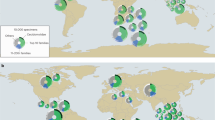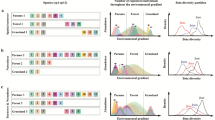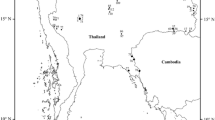Abstract
Flies (Diptera) are the dominant animal in the North yet are underrepresented in ecological studies. Our study aimed to examine the diversity patterns of the poorly documented acalyptrate flies across the Canadian North. Our main objective was to determine large- and small-scale drivers of species richness, abundance and community composition of acalyptrate fly assemblages. We collected flies at 12 Canadian sites in three ecoclimatic zones (Northern Boreal, Sub-Arctic and High Arctic), from two habitats (wet and mesic). We tested the effect of climatic variables and habitat on species richness and abundance using a generalized linear mixed-effects model, and on community composition using permutational multivariate analysis of variance. Species turnover between sites and ecoclimatic zones was examined by testing for multivariate homogeneity of group dispersions and visualised using non-metric multidimensional scaling. We identified 3631 acalyptrate flies, belonging to 333 species. Diversity measures and community composition were associated with seasonal and limiting temperature variables, consistent with the latitudinal diversity gradient seen in other animal groups. However, habitat only explained a small portion of the variation in our data, and only for observed species richness and species composition. Turnover patterns showed slight, statistically non-significant variation across zones. The High Arctic ecoclimatic zone was as spatially heterogenous in composition as the Northern Boreal and Sub-Arctic ecoclimatic zones but hinted at complex interplays between geographical and glacial legacies. Our results contradict the historical view of Arctic arthropod diversity as simple and uniform, and may serve as a baseline for future biodiversity monitoring.




Similar content being viewed by others
References
Anderson MJ (2001) A new method for non-parametric multivariate analysis of variance. Austral Ecol 26:32–46
Anderson MJ, Ellingsen KE, McArdle BH (2006) Multivariate dispersion as a measure of beta diversity. Ecol Lett 9:683–693
Bale JS, Hayward SAL (2010) Insect overwintering in a changing climate. J Exp Biol 213:980–994
Bartoń K (2018) MuMIn: multi-model inference. R package version 1.40.4
Baselga A (2010) Partitioning the turnover and nestedness components of beta diversity. Glob Ecol Biogeogr 19:134–143
Blair MS, Rochefort S, Solecki AM, Vajda E, Wheeler TA (2012) Two wings over the tundra: higher diptera research in the Northern Biodiversity Program. Newsl Biol Surv Can 31:16–22
Böcher J (2015a) The Greenland entomofauna in its Arctic context. In: Böcher J, Kristensen NP, Pape T, Vilhelmsen L (eds) The Greenland entomofauna. An identification manual of insects, spiders and their allies. Fauna Entomologica Scandinavica 44. Brill, Leiden, pp 10–20
Böcher J (2015b) The Greenland entomofauna: zoogeography and history. In: Böcher J, Kristensen NP, Pape T, Vilhelmsen L (eds) The Greenland entomofauna. An identification manual of insects, spiders and their allies. Fauna Entomologica Scandinavica 44. Brill, Leiden, pp 21–36
Boucher S (1998) Origins and zoogeography of flies (Insecta: Diptera) in Southern Yukon grasslands. Arct 51:399–402
Boucher S, Wheeler TA (2001) Diversity of Agromyzidae (Diptera) in disjuncts grasslands of the southern Yukon Territory. Can Entomol 133:593–621
Bowden JJ, Eskildsen A, Hansen R, Olsen K, Kurle CM, Høye TT (2015) High-Arctic butterflies become smaller with rising temperatures. Biol Lett 11:20150574
Brubaker LB, Anderson PM, Hu FS (1995) Arctic tundra biodiversity: a temporal perspective from late quaternary pollen records. In: Chapin FS, Körner C (eds) Arctic and alpine biodiversity: patterns, causes, and ecosystem consequences. Springer, Berlin, pp 111–125
Chao A, Chazdon RL, Colwell RK, Shen T-J (2005) A new statistical approach for assessing similarity of species composition with incidence and abundance data. Ecol Lett 8:148–159
Chao A, Gotelli NJ, Hsieh TC, Sander EL, Ma KH, Colwell RK, Ellison AM (2014) Rarefaction and extrapolation with Hill numbers: a framework for sampling and estimation in species diversity studies. Ecol Monogr 84:45–67
Colwell RK, Coddington JA (1994) Estimating terrestrial biodiversity through extrapolation. Philos Trans R Soc B 345:101–118
Courtney GW, Pape T, Skevington JH, Sinclair BJ (2009) Biodiversity of diptera. In: Foottit RG, Adler PH (eds) Insect biodiversity: science and society. Blackwell, Oxford, pp 185–222
Danks HV, Downes JA (1997) Insects of the Yukon. Biological Survey of Canada monograph series no. 2, Biological Survey of Canada (Terrestrial Arthropods), Ottawa
Danks HV, Smith ABT (2009) Insect biodiversity in the Nearctic region. In: Foottit RG, Adler PH (eds) Insect biodiversity: science and society. Blackwell, Oxford, pp 35–48
Dray S, Dufour AB, Chessel D (2007) The ade4 package—II: two-table and K-table methods. R News 7:47–52
Dyke AS (2004) An outline of North American deglaciation with emphasis on central and northern Canada. In: Ehlers J, Gibbard PL (eds) Quaternary glaciations—extent and chronology, part II: North America: developments in quaternary science 2. Elsevier, Amsterdam, pp 373–424
Elberling H, Olesen JM (1999) The structure of a high latitude plant-flower visitor system: the dominance of flies. Ecography 22:314–323
Ernst CM, Buddle CM (2013) Seasonal patterns in the structure of epigeic beetle (Coleoptera) assemblages in two subarctic habitats in Nunavut, Canada. Can Entomol 145:171–183
Ernst CM, Buddle CM (2015) Drivers and patterns of ground-dwelling beetle biodiversity across northern Canada. PLoS ONE 10:e0122163
Ernst CM, Loboda S, Buddle CM (2015) Capturing northern biodiversity: diversity of arctic, subarctic and north boreal beetles and spiders are affected by trap type and habitat. Insect Conserv Divers 9:63–73
Ferrar P (1987) A guide to the breeding habits and immature stages of Cyclorrhapha, part I. Entomograph 8. Brill, Leiden
Fick SE, Hijmans RJ (2017) WorldClim 2: new 1-km spatial resolution climate surfaces for global land areas. Int J Climatol 37:4302–4315
Fox J, Weisberg S (2011) An R companion to applied regression, 2nd edn. Sage, Thousand Oaks
Hansen RR, Hansen OLP, Bowden JJ, Normand S, Bay C, Sørensen JG, Høye TT (2016) High spatial variation in terrestrial arthropod species diversity and composition near the Greenland ice cap. Polar Biol 39:2263–2272
Harrington CR (2005) The eastern limit of Beringia: mammoth remains from Banks and Melville Islands, Northwest Territories. Arctic 58:361–369
Hebert PDN, Ratnasingham S, Zakharov EV, Telfer AC, Levesque-Beaudin V, Milton MA, Pedersen S, Janetta P, deWaard JR (2016) Counting animal species with DNA barcodes: Canadian insects. Philos Trans R Soc B 371:20150333
Hijmans RJ (2017) raster: geographic data analysis and modeling. R package version 2.6-7
Hodkinson ID, Babenko A, Behan-Pelletier V, Böcher J, Boxshall G, Brodo F, Coulson SJ, De Smet W, Dózsa-Farkas K, Elias S, Fjellberg A, Fochetti R, Foottit R, Hessen D, Hobaek A, Holmstrup M, Koponen S, Liston A, Makarova O, Marusik YM, Michelsen V, Mikkola K, Mustonen T, Pont A, Renaud A, Rueda LM, Savage J, Smith H, Samchysyna L, Velle G, Viehberg F, Vikberg V, Wall DH, Weider LJ, Wetterich S, Yu Q, Zinovjev A (2013) Terrestrial and freshwater invertebrates. In: Meltofte H (ed) Arctic biodiversity assessment. Status and trends in Arctic biodiversity. Conservation of Arctic Flora and Fauna, Akureyri, pp 247–275
Hortal J, Diniz-Filho JAF, Bini LM, Rodríguez MA, Baselga A, Nogués-Bravo D, Rangel TF, Hawkins BA, Lobo JM (2011) Ice age climate, evolutionary constraints and diversity patterns of European dung beetles. Ecol Lett 14:741–748
Høye TT, Forchhammer MC (2008) Phenology of high-Arctic arthropods: effects of climate on spatial, seasonal, and inter-annual variation. Adv Ecol Res 40:299–324
Høye TT, Post E, Schmidt NM, Trøjelsgaard K, Forchhammer MC (2013) Shorter flowering seasons and declining abundance of flower visitors in a warmer Arctic. Nat Clim Change 3:759–763
Hsieh TC, Ma KH, Chao A (2016) iNEXT: iNterpolation and EXTrapolation for species diversity. R package version 2.0.12
Loboda S, Buddle CM (2018) Small to large-scale patterns of ground-dwelling spider (Araneae) diversity across northern Canada. FACETS 3:880–895
Loboda S, Savage J, Buddle CM, Schmidt NM, Høye TT (2018) Declining diversity and abundance of high Arctic fly assemblages over two decades of rapid climate warming. Ecography 41:265–277
MacInnes KL (1973) Reproductive ecology of five Arctic species of Pedicularis (Scrophulariaceae). Dissertation, University of Western Ontario
Marshall SA (2012) Flies: The natural history and diversity of Diptera. Firefly Books, Richmond Hill
McAlpine JF (1987) Piophilidae. In: McAlpine JF, Peterson BV, Shewell GE, Teskey HJ, Vockeroth JR, Wood DM (eds) Manual of nearctic Diptera. Monograph no 28. Agriculture Canada, Ottawa, pp 845–852
McBean G, Alekseev G, Chen D, Førland E, Fyfe J, Groisman PY, King R, Melling H, Vose R, Whitfield PH (2005) Arctic climate: past and present. In: Symon C, Arris L, Heal B (eds) Arctic climate impact assessment. Cambridge University Press, Cambridge, pp 21–60
Mei M, Gibson JF, Skevington JH (2010) Observations on hilltopping in thick-headed flies (Diptera: Conopidae). J Insect Sci 10:27
Oksanen J, Blanchet FG, Friendly M, Kindt R, Legendre P, McGlinn D, Minchin PR, O'Hara RB, Simpson GL, Solymos P, Stevens MHH, Szoecs E, Wagner H (2018) vegan: community ecology package. R package version 2.4-6
Post E, Forchhammer MC, Bret-Harte MS, Callaghan TV, Christensen TR, Elberling B, Fox AD, Gilg O, Hik DS, Høye TT, Ims RA, Jeppesen E, Klein DR, Madsen J, McGuire AD, Rysgaard S, Schindler DE, Stirling I, Tamstorf MP, Tyler NJC, van der Wal R, Welker J, Wookey PA, Schmidt NM, Aastrup P (2009) Ecological dynamics across the Arctic associated with recent climate change. Science 325:1355–1358
R Core Team (2018) R: a language and environment for statistical computing. R Foundation for Statistical Computing, Vienna
Renaud AK, Savage J, Roughley RE (2012) Muscidae (Diptera) diversity in Churchill, Canada, between two time periods: evidence for limited changes since the Canadian Northern Insect Survey. Can Entomol 144:29–51
Rich ME, Gough L, Boelman NT (2013) Arctic arthropod assemblages in habitats of differing shrub dominance. Ecography 36:994–1003
Rochefort S, Wheeler TA (2015) Diversity of Piophilidae (Diptera) in northern Canada and description of new Holarctic species of Parapiophila McAlpine. Zootaxa 3925:229–240
Roslin T, Majaneva S (2016) The use of DNA barcodes in food web construction—terrestrial and aquatic ecologists unite! Genome 59:603–628
Schaefer P (2014) Diversity and ecological structure in Northern biting flies. Dissertation, University of Toronto
Solecki AM, Buddle CM, Wheeler TA (2016) Distribution and community structure of chloropid flies (Diptera: Chloropidae) in Nearctic glacial and post-glacial grasslands. Insect Conserv Divers 9:358–368
Strong W, Zoltai SC, Ecoregions Working Group, Canada Committee on Ecological Land Classification (1989) Ecoclimatic regions of Canada: first approximation. Sustainable Development Branch, Canadian Wildlife Service, Ottawa
Summerhayes VS, Elton CS (1923) Contributions to the ecology of Spitsbergen and Bear Island. J Ecol 11:214–286
Timms LL, Bennett AMR, Buddle CM, Wheeler TA (2013) Assessing five decades of change in a high Arctic parasitoid community. Ecography 36:1227–1235
Tribsch A, Schönswetter P (2003) Patterns of endemism and comparative phylogeography confirm palaeoenvironmental evidence for Pleistocene refugia in the Eastern Alps. Taxon 52:477–497
Venables WN, Ripley BD (2002) Modern applied statistics with S, 4th edn. Springer, New York
Vernon P, Vannier G, Trehen P (1998) A comparative approach to the entomological diversity of polar regions. Acta Oecol 19:303–308
Walker MD (1995) Patterns and causes of Arctic plant community diversity. In: Chapin FS, Körner C (eds) Arctic and alpine biodiversity: patterns, causes, and ecosystem consequences. Springer, Berlin, pp 3–20
Willig MR, Kaufman DM, Stevens RD (2003) Latitudinal gradients of biodiversity: pattern, process, scale, and synthesis. Annu Rev Ecol Evol Syst 34:273–309
Wirta HK, Vesterinen EJ, Hambäck PA, Weingartner E, Rasmussen C, Reneerkens J, Schmidt NM, Gilg O, Roslin T (2015) Exposing the structure of an Arctic food web. Ecol Evol 5:3842–3856
Zuur AF, Ieno EN, Smith GM (2007) Analyzing ecological data. Springer, New York
Acknowledgements
Terry A. Wheeler passed away during the preparation of this manuscript. His passion and mentorship provided us with the passion and tools to pursue an academic career. We would like to dedicate this manuscript to him, acknowledging the substantial impact he had on our lives and on that of many others. This project was part of a considerable effort, with numerous collaborators. We thank Doug Currie, Sarah Loboda, Katie Sim, Laura Timms, Christopher M. Buddle, Christopher Ernst, Maegan Blair, Patrick Schaeffer, Jana Aker, Christine Roussel, Donna Giberson, Ruben Cordero, Brad Hubley, Sabrina Rochefort and Elodie Vajda for their invaluable help in collecting and sorting specimens. We also thank Sabrina Rochefort, Kevin N. Barber and Tadeusz Zatwarnicki for their help in identifying the dipteran families Piophilidae, Anthomyza:Anthomyzidae and Ephydridae, respectively. The Srivastava Lab, and especially Diane Srivastava and Laura Melissa Guzman, provided numerous comments on the analysis and earlier versions of the manuscript. Florent Mazel provided valuable insights on the analysis. We also thank Christopher M. Buddle for his feedback on later versions of this manuscript, and the reviewers for their invaluable comments which also helped us improve it. Permits for arthropod collection in the Arctic were granted by Aurora Research Institute, Environment Yukon Parks Branch, the Yukon Scientists and Explorer’s Act, the Nunavut Wildlife Act and Parks Canada Agency (Research and Collection Permit for Lake Hazen). Arthropods in Churchill, MB, were collected under a permit issued by the Manitoba Conservation Wildlife and Ecosystem Protection Branch from Winnipeg, MB, to the Churchill Northern Studies Center (CNSC) for conducting research in the Manitoba Wildlife Management Area. Financial support was provided by the Natural Sciences and Engineering Research Council of Canada (Canada Graduate Scholarship; Strategic Project Grant to C.M. Buddle, T.A. Wheeler, D.C. Currie; Discovery Grant and Northern Research Supplement to T.A. Wheeler); the Polar Continental Shelf Program; The Schad Foundation; the Northern Scientific Training Program; the Entomological Society of Canada Postgraduate Award, McGill University (E. Melville Duporte Award, GREAT Travel Awards); Fonds de recherche du Québec – Nature et technologies (Masters Research Scholarship); the Canadian Northern Studies Trust and the W. Garfield Weston Foundation (W. Garfield Weston Award for Northern Research).
Author information
Authors and Affiliations
Corresponding author
Ethics declarations
Conflict of interest
The authors have no conflict of interest to report.
Additional information
Publisher's Note
Springer Nature remains neutral with regard to jurisdictional claims in published maps and institutional affiliations.
Electronic supplementary material
Below is the link to the electronic supplementary material.
Rights and permissions
About this article
Cite this article
Rogy, P., Wheeler, T.A. & Solecki, A.M. Spatial distribution of acalyptrate fly (Diptera) assemblages in Northern Canada. Polar Biol 42, 1489–1500 (2019). https://doi.org/10.1007/s00300-019-02535-y
Received:
Revised:
Accepted:
Published:
Issue Date:
DOI: https://doi.org/10.1007/s00300-019-02535-y




